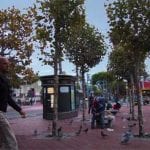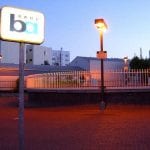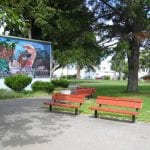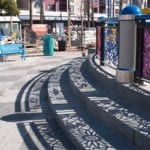The 16th Street BART Community Design Plan is the result of a nine-month community planning process organized to address neighborhood concerns about the 16th Street BART station area in San Francisco. The Community Design Plan provides both general guidelines and specific proposals for improvements to the station area. The report itself also provides a general overview of the station area and its surroundings. Lastly, the report provides cost estimates, funding scenarios, and strategies for implementation.
The Community Design Plan was created by bringing community members together with transportation and planning professionals in order to share experiences, establish goals, and solve problems related to the transit plazas. From focus groups to design charettes, over 100 people and organizations participated actively in the community planning process.
After the basic site plan had been established through the community workshops, it was reviewed by staff at BART, MTC, and the SFCTA. BART, in particular, conducted a project review with staff from engineering, operations, access and facilities planning, maintenance, police, and real estate.
The issues at 16th and Mission-such as access to transit, public safety, and homelessness-are vitally important to the future of the Mission District. To begin with, thousands of low-income people depend on the station area in order to reach much-needed public transit. In addition, in a neighborhood that is sorely lacking in parks, the transit plazas are crucial, but imperfect, open spaces. It is essential to find a way for commuters, homeless people, and other community members to share this important public space.
In order to address these issues, community members identified three principles to guide the Community Design Plan: increase accessibility and choices; improve visibility and connectivity; and encourage a diverse range of activities and people on the plazas.
Visibility and accessibility will be addressed first by removing many of the visual and physical barriers that currently give the plazas a fortress-like quality and make pedestrian circulation difficult.
In order to create a vibrant, active atmosphere on the plazas, the Community Design Plan provides space for new commercial and community activities. The intent is to draw more people to the plazas in the evening and on the weekends. These activities and facilities are intended principally to serve the existing low-income community that surrounds the plazas.
Lastly, the Community Design Plan aims to eliminate the sense of disorientation and placelessness experienced at the station by connecting the plazas to adjacent buildings and installing locally created public art throughout the area. The intent is to create a station area that draws on the unique assets of the Mission District.
The estimated cost of the design and construction of the physical improvements is approximately $4.5 million. The completion of the 16th Street BART Community Design Plan now enables the public agency partners in this project to apply for funding for the improvements outlined in Section 2. This implementation of the project is expected to take 3-5 years.
16th Street BART Plazas Community Design Plan
Mission Housing Development Corporation
Bay Area Rapid Transit
Metropolitan Transportation Commission
Urban Ecology
The issues at 16 th and Mission transit access, public safety, and homelessness are vitally important to the future of the Mission District. Thousands of low-in- come people depend on the station in order to reach jobs and services. In a neighborhood that is sorely lacking in parks, the transit plazas are also crucial, but imperfect, open spaces.
The plan aims to find a way for commut- ers, the homeless, and other community members to share this important public space. Three principles guide the design: increase accessibility and choices; improve visibility and connectivity; and encourage a diverse range of activities and people on the plazas.
Visibility and accessibility will be addressed by removing the visual and physical barri- ers that give the plazas a fortress-like qual- ity and impede pedestrian circulation. In order to create a vibrant, active atmosphere on the plazas, space will be provided for vendor stalls, an outdoor seating area, stages, and a new community center, cre- ating an urban zócalo, or traditional town plaza. The intent is to draw more people to the plazas in the evening and on the weekends, with activities and facilities that serve the existing working-class commu- nity surrounding the plazas. Lastly, the design aims to eliminate the sense of dis- orientation and placelessness experienced at the station by connecting the plazas to adjacent buildings and installing locally created public art.
The estimated cost of the design and con- struction of the physical improvements is approximately $4.5 million. BART is leading the capital improvement phase for the southeast plaza, which broke ground in 2001.
http://www.urbanecology.org/neighborhood/16.pdf






